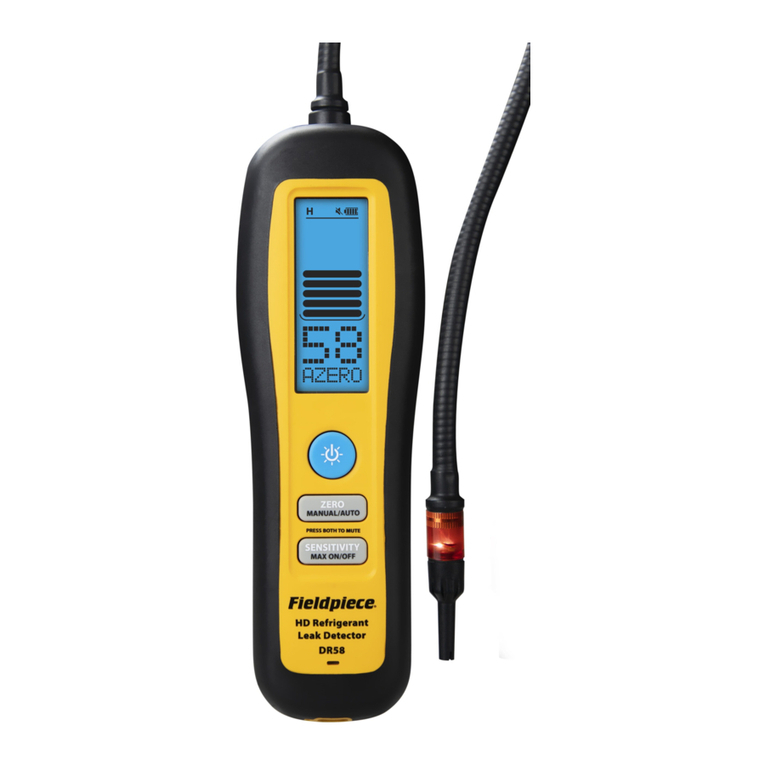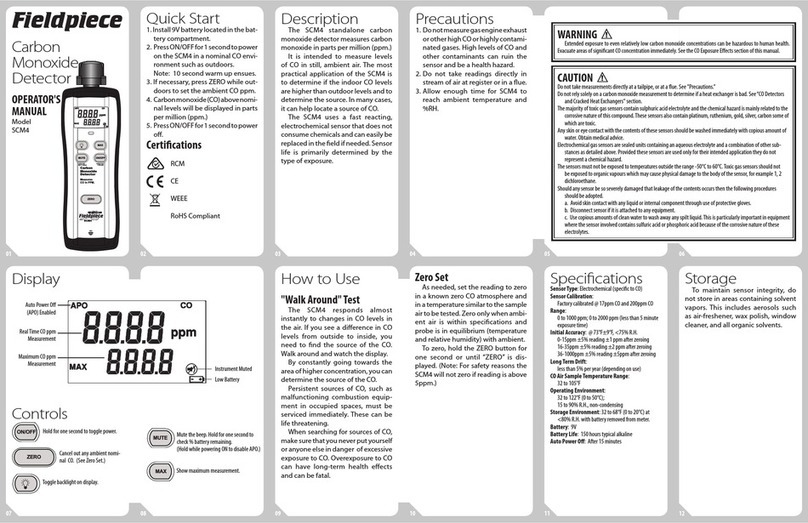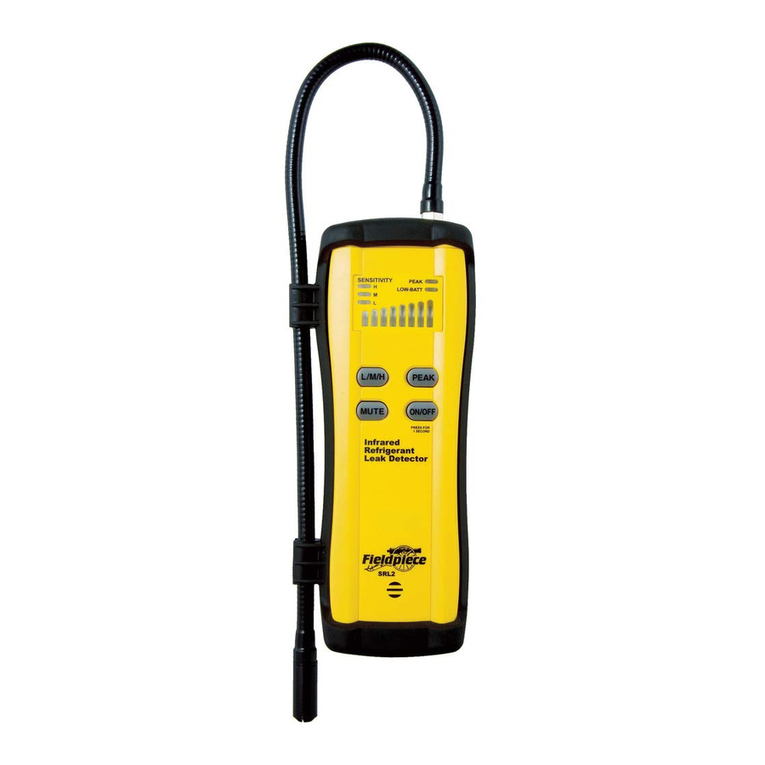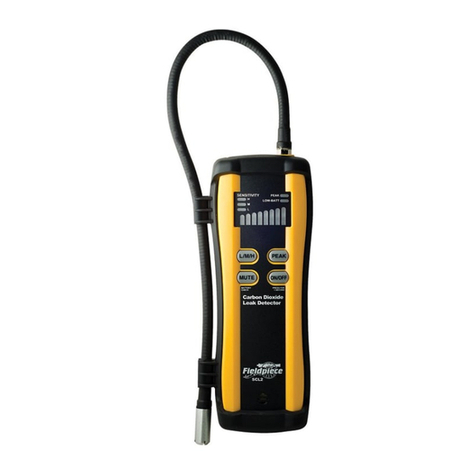01 03 0602 0504
07 09 1208 1110
Quick Start
1. Install 9V battery (included).
2. Connect ACM4 to Fieldpiece Meter.
3. Select the mVDC range on DMM.
4. Slide the power switch to ON and
allow the warmup to complete.
Note: Green and red LEDs will light
solidly for 10 seconds.
5. If necessary, ZERO the ACM4 to
atmosphere with no carbon mon-
oxide (CO).
6. Carbonmonoxide(CO)abovenomi-
nal levels will be displayed in parts
per million (ppm).
7. PowerACM4obyslidingthepower
switch to the OFF position.
Certifications
C-Tick (N22675)
CE
WEEE
RoHS Compliant
Description
The ACM4 carbon monoxide
accessory head measures carbon
monoxide in parts per million (ppm).
It is intended to measure levels
of CO in still, ambient air. The most
practical application of the ACM4 is
to determine if the indoor CO levels
are higher than outdoor levels and to
determine the source. In many cases,
it can help locate a source of CO.
The ACM4 uses a fast reacting,
electrochemical sensor that does not
consume chemicals and can easily be
replaced in the eld if needed. Sensor
Life is primarily determined by the
type of exposure.
Precautions
1. Do not measure gas engine
exhaust or other high CO or highly
contaminated gases. High levels of
COand other contaminants can ruin
the sensor and be a health hazard.
2. Do not take readings directly in
stream of air at register or in a ue.
3. Allow enough time for ACM4 to
reach ambient temperature and
%RH.
4. The sensor has built-in permanent
non-replaceable filter to filter
out trace concentrations of SO2,
NO2, and most hydrocarbons. If
exposed to high concentrations of
harmfulchemicalssuchasmethanol,
ethanol, or dirt, the filter can
deteriorateand/or impede diusion
of CO to the sensor.
Fieldpiece
Carbon Monoxide
Accessory Head
OPERATOR'S
MANUAL
Model
ACM4
How to Use
1. Connect COM and Volts jacks using
Fieldpiece deluxe test leads. For
Fieldpiece "stick" meter, slide the
head directly over the meter.
2. Select the mVDC range.
3. PowerACM4on byslidingthepower
switch to the ON position and allow
warmup to complete.
4. Take the instrument outside and
adjust it to zero. Then bring inside
to take measurements.
5. Expose sensor to a still, stable air
sample (see precautions). The dis-
play reacts to the presence of CO
in seconds.Take nal reading when
reading stabilizes.
6. For initial tests, walk around the
building, watch for the readings
to go up to determine where
maximum concentrations of CO
are present. To measure air from
register, use a pump or measure
out of the air stream. Hot blowing
air can adversely aect the reading.
Thetemperatureofthesamplemust
be near ambient.
Zero Adjust
As needed, set the reading to zero in
a known zero CO atmosphere and in a
temperature similar to the sample air
to be tested. Zero only when ambient
air is within specications and probe
is in equilibrium (temperature and
relative humidity) with ambient.
To zero, removing the protective
rubber cover to access the calibration
screw. Using the calibration Tool
provided, turn the calibration screw
until the display reads ZERO. (Note:
For safety reasons the ACM4 will not
zero if reading is above 5ppm.)
"Walk Around" Test
The ACM4 responds almost
instantly to changes in CO levels in
the air. If you see a difference in CO
levels from outside to inside, you
need to find the source of the CO.
Walk around and watch the display.
By constantly going towards the
area of higher concentration, you can
determine the source of the CO.
Persistent sources of CO, such
as malfunctioning combustion
equipment in occupied spaces, must
be serviced immediately. These can
be life threatening.
When searching for sources of CO,
make sure that you never put yourself
or anyone else in danger of excessive
exposure to CO. Overexposure to CO
can have long-term health eects and
can be fatal.
Average Switch
The average switch averages the
reading over the last two or three
seconds. This allows the user to read
more stable measurements.
Specifications
Sensor Type: Electrochemical (specic to CO)
Sensor Calibration: Factory calibrated @ 205 ppm CO
Range: 0 to 1000 ppm;
0 to 2000 ppm (less than 5 minute exposure time)
Initial Accuracy: @ 73°F±9°F, <75% R.H.
0-15ppm ±5% reading ±1 ppm after zeroing
16-35ppm ±5% reading ±2 ppm after zeroing
36-1000ppm ±5% reading ±5ppm after zeroing
Long Term Drift: less than 5% per year
(depending on use)
CO Air Sample Temperature Range: 32 to 105°F
Operating Environment: 32 to 122°F (0 to 50°C);
15 to 90% R.H., non-condensing
Storage Environment: 32 to 68°F (0 to 20°C) at
<80% R.H. with battery removed from meter.
Battery: 9V.
Battery Life: 150 hours typical alkaline.
Auto Power O: After 15 minutes.
Storage
To maintain sensor integrity, do
not store in areas containing solvent
vapors. This includes aerosols such
as air-freshener, wax polish, window
cleaner, and all organic solvents.
CO Detectors and
Cracked Heat
Exchangers
A CO detector cannot tell you
if a heat exchanger is good. A CO
detector can indicate that a heat
exchanger may be cracked only if
all of the following conditions occur
simultaneously:
1. The ame must generate high con-
centrations of CO (lack of oxygen,
excess fuel, high temp).
2.Enough exhaust gases must be emit-
ted from the heat exchanger crack.
3. The exhaust gases from the crack
must not be diluted too much
before coming in contact with the
sensor. A cracked heat exchanger
may leak CO in a small stream. You
may measure high concentrations
at one point but low concentrations
only an inch away.
4.Theheatexchanger must be the only
possiblesourceforthe COdetected.
CO Exposure Effects
Note: Eects can vary signicantly depending on
age, sex, weight, and overall health.
CAUTION

























